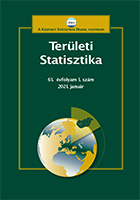Élmények a zöldfelületeken: A megélt tér különbségei Stockholmban
Experiences in urban green spaces: Differences in lived spaces in Stockholm
Author(s): Dalma SchmellerSubject(s): Social Sciences, Economy, Geography, Regional studies
Published by: Központi Statisztikai Hivatal
Keywords: Stockholm; urban green spaces; sociotope; public participatory GIS
Summary/Abstract: Nowadays, the leisure time of the inhabitants is increasing, which means that the utility of urban green spaces is becoming more and more valuable, as people visit these places more often and for longer periods to spend their spare time. In the aftermath of the coronavirus pandemic, these open spaces are playing an even more important role in social interaction. The features used by different groups of the society (sociotopes), the aesthetics and the atmosphere of the green spaces all influence the experiences gained in the area, which can also determine our perception and opinion of the given space. The present research aims to show, through the example of Stockholm's green spaces, the factors responsible for good or bad experiences and whether there is any correlation between these and the types of urban green spaces. Stockholm was the first city to win the European Green Capital Award in 2010, demonstrating that it is a leader in environmental thinking and a role model for other Europe-an or even Hungarian (Budapest, Pécs) cities that have also applied for the European Green Capital Award but were not shortlisted as finalists. Stockholm can also be described as 'part water, part green belt, part city', as stated in an official document published by the European Commission (2010, p. 21). Stockholm ranks highly among European cities in terms of green space accessibility (Buckland & Pojani 2022), Green City Index score and environmental poli-cy (Akande et al. 2019), as well as in terms of public satisfaction with the quality of life in the city (Okulicz-Kozaryn 2013), and can therefore serve as a best practice model for other cities. In this study, a categorisation of Stockholm's green spaces was carried out, using Ibes' (2015) study as a basis. Based on this, six categories can be distinguished by using ten variables. The green space categories identified in the analysis show differences in the number of sociotope functions and differences in the temporal (time of day, season, length of stay), frequency (visits to the area) and economic (cost of services in the area) aspects of these categories are also observable.
Journal: Területi Statisztika
- Issue Year: 63/2023
- Issue No: 02
- Page Range: 234-266
- Page Count: 33
- Language: Hungarian

